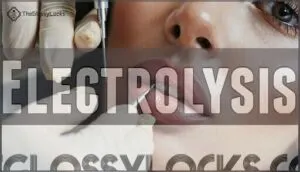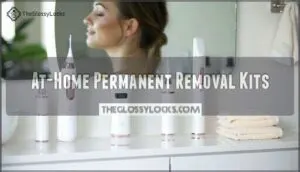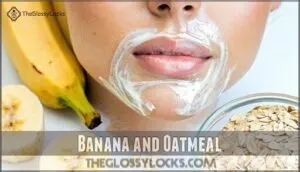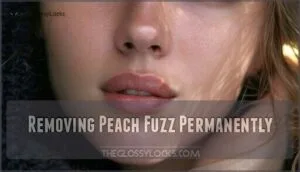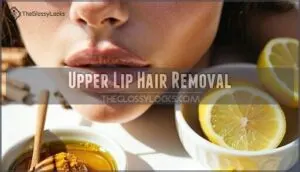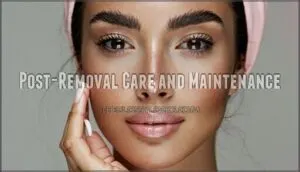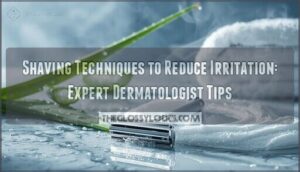This site is supported by our readers. We may earn a commission, at no cost to you, if you purchase through links.
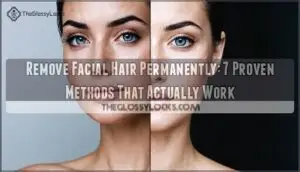 You can remove facial hair permanently through two clinically proven methods: laser hair removal and electrolysis.
You can remove facial hair permanently through two clinically proven methods: laser hair removal and electrolysis.
Laser treatments target hair follicles with concentrated light beams, requiring 6-8 sessions for desirable results. It’s most effective on dark hair against light skin.
Electrolysis destroys individual follicles with electrical current and works on all hair colors, though it’s more time-consuming.
Both procedures should be performed by licensed professionals to avoid complications like burns or scarring. While at-home devices exist, they’re less powerful than professional treatments.
Natural remedies won’t give you permanent results despite popular claims. The key lies in understanding which method suits your specific hair type and skin tone.
Table Of Contents
- Key Takeaways
- Facial Hair Removal Methods
- Permanent Hair Removal Options
- Natural Remedies for Hair Removal
- Removing Peach Fuzz Permanently
- Upper Lip Hair Removal
- Precautions and Risks
- Post-Removal Care and Maintenance
- Frequently Asked Questions (FAQs)
- Is it possible to permanently remove facial hair?
- How can I remove hair from my face permanently naturally?
- How do Koreans remove facial hair permanently?
- How to remove peach fuzz permanently?
- What causes excessive facial hair in women?
- How much does professional electrolysis treatment cost?
- Can hormonal changes affect hair removal results?
- Are there medical conditions requiring hair removal?
- When should someone consult a dermatologist first?
- Conclusion
Key Takeaways
- You can permanently remove facial hair through electrolysis, the only FDA-approved method that destroys hair follicles completely, or laser hair removal, which offers long-term reduction but may work better on dark hair and light skin.
- At-home devices like IPL systems are less effective than professional treatments and might cause irritation, requiring consistent and proper use.
- Natural remedies like turmeric can weaken hair temporarily but don’t provide permanent results.
- Consulting licensed professionals for electrolysis or laser treatments ensures safe and effective outcomes, reducing risks like burns or scarring.
Facial Hair Removal Methods
You’ll find three main categories of facial hair removal methods that range from quick daily fixes to permanent solutions.
Each approach offers different benefits regarding duration, cost, and effectiveness, so understanding your options helps you choose the method that best fits your lifestyle and hair removal goals, considering factors like duration.
Temporary Removal Techniques
You’ll often find yourself reaching for quick fixes when unwanted facial hair appears.
These temporary methods offer immediate results but require frequent maintenance.
- Shaving – Despite shaving concerns about stubble, it’s safe and won’t make hair thicker
- Tweezing – Plucks from the root but tweezing risks include inflammation and ingrown hairs
- Waxing – Removes hair for weeks, though waxing irritation affects sensitive skin
- Threading – Precise removal lasting 4-5 weeks
Semi-Permanent Removal Techniques
When temporary methods feel like chasing your tail, semi-permanent techniques offer breathing room.
These methods target hair follicles more aggressively than surface removal, delivering weeks to months of smooth skin.
| Method | Duration | Pain Level |
|---|---|---|
| IPL hair removal | 4-8 weeks | Moderate |
| At-home lasers | 6-12 weeks | Mild-Moderate |
| Professional safety treatments | 8-16 weeks | Variable |
Treatment costs vary substantially based on professional versus home use.
Permanent Removal Techniques
True permanent hair removal requires advanced techniques that target hair follicles at their source.
These methods offer lasting results but demand professional guidance and financial investment.
- Electrolysis hair removal destroys follicles permanently using electrical current
- Laser hair removal provides permanent hair reduction through targeted light therapy
- Professional guidance guarantees the best results and minimizes treatment risks
- At-home safety concerns make clinic visits worthwhile investments
- Treatment costs vary substantially between electrolysis efficacy and laser limitations
Permanent Hair Removal Options
When you’re tired of daily shaving routines and weekly waxing appointments, permanent hair removal methods offer a long-term solution that targets hair follicles directly.
These clinically proven techniques use advanced technology to damage or destroy follicles, giving you months or even years of smooth, hair-free skin.
Laser Hair Removal
Targeting hair follicles with concentrated light beams, laser hair removal offers impressive laser efficacy for permanent facial hair removal.
You’ll need multiple laser treatments spaced weeks apart, with session frequency depending on your skin type.
Treatment cost varies by location, but expect investment over time, and potential side-effects include temporary redness and swelling, making professional hair removal laser sessions your safest bet, especially for permanent results.
Electrolysis
Electrolysis stands as the only FDA-approved method for permanent facial hair removal, targeting individual hair follicles with precise electric current.
Looking for truly permanent results? Electrolysis destroys each follicle completely—the only FDA-approved method that delivers lasting hair-free skin.
This electrolysis process destroys each follicle completely, ensuring hair follicle destruction that’s truly permanent.
While electrolysis cost and time commitment are significant, electrolysis effectiveness surpasses all other hair removal methods.
Electrolysis safety remains excellent with minimal side-effects when performed professionally.
The procedure uses a sterile probe insertion to target the areas responsible for hair growth.
At-Home Permanent Removal Kits
At-home treatments offer convenient alternatives to professional electrolysis, though kit effectiveness varies substantially.
FDA-approved hair removal devices like IPL systems target hair follicle destruction but require consistent use.
Cost comparison favors home kits over salon visits, yet user reviews reveal mixed long-term results.
Safety concerns include potential skin irritation without professional oversight, making proper research essential before purchasing.
Some devices use diode laser technology for deeper follicle penetration, which is a key factor in hair removal and follicle destruction, and also considers professional electrolysis.
Natural Remedies for Hair Removal
While natural remedies won’t permanently remove facial hair like electrolysis or laser treatments, these kitchen-based methods can temporarily weaken hair follicles and provide gentler alternatives to chemical depilatories.
You’ll find ingredients like lemon juice, turmeric, and oatmeal work as mild exfoliants that may reduce hair thickness over time, though results vary substantially between individuals and require consistent application.
Lemon Juice and Sugar
DIY hair removal enthusiasts swear by this sugar-lemon combination for natural facial hair removal methods. Combine two parts pureed fruit with granulated sugar and one tablespoon lemon juice.
Boil until smooth, simmer fifteen minutes until thick. Apply warm mixture using proper application techniques, pulling against hair growth direction.
This remedy effectiveness comes from sugar exfoliation while lemon juice naturally lightens remaining hair. For a reliable method, explore a sugar wax recipe.
However, be mindful of lemon photosensitivity. This is a crucial consideration to ensure safe and effective use of the natural facial hair removal method.
Banana and Oatmeal
Creating this homemade mask combines nature’s gentle abrasion with DIY exfoliation.
Grind oats to breadcrumb consistency, then mix with mashed banana for natural ingredients that work on sensitive skin.
Apply evenly, wait fifteen minutes, then scrub against hair growth direction.
You can purchase a pre-made version for convenience.
This natural remedy removes facial hair while exfoliating dead skin cells—your skin gets smoother without harsh chemicals, using natural ingredients.
Lemon and Honey
Lemon juice and honey create a powerful natural hair removal combination that’s gentler than traditional waxing. The lemon’s acidity weakens hair follicles while honey’s antimicrobial properties soothe sensitive skin during application.
Key application methods for best results:
- Mix equal parts fresh lemon juice and raw honey into a thick paste
- Apply mixture in the direction of hair growth using clean fingers
- Place a cloth strip over the paste and press firmly for 30 seconds
- Pull strip quickly in the opposite direction of hair growth for effective removal
This DIY treatment offers honey benefits including natural moisturizing effects, making it ideal for facial hair removal on delicate areas. For a convenient alternative, consider purchasing pre-made options. Recipe variations can include adding a pinch of sugar for enhanced grip during the removal process.
Oatmeal, Honey, and Lemon Juice
Three powerhouse ingredients combine to create nature’s gentle hair removal solution.
This DIY exfoliation method harnesses oatmeal’s natural abrasive properties, honey’s moisturizing benefits, and lemon juice’s gentle astringent effects.
The remedy effectiveness lies in consistent application technique – blend ingredients, massage against hair growth direction, then rinse with cold water for maximum skin benefits.
| Ingredient | Primary Function | Skin Benefits |
|---|---|---|
| Oatmeal | Natural exfoliant | Removes dead skin cells |
| Honey | Moisturizer | Soothes and hydrates |
| Lemon Juice | Gentle astringent | Lightens hair naturally |
| Combined | Hair removal aid | Reduces regrowth rate |
Turmeric and Milk
Another ancient remedy combines turmeric’s anti-inflammatory properties with milk’s gentle moisturizing effects for natural facial hair removal.
This golden paste offers a mess-free alternative that many find surprisingly effective.
Here’s your step-by-step application method:
- Mix three teaspoons turmeric with one teaspoon milk – creating a thick, spreadable paste
- Apply evenly to target areas – covering unwanted facial hair completely
- Wait 20 minutes until completely dry – allowing active compounds to work
- Scrub off with circular motions – using wet hands before rinsing with lukewarm water
Removing Peach Fuzz Permanently
That fine, downy hair covering your face might seem harmless, but you’ll want more than temporary fixes if it’s bothering you regularly.
While peach fuzz can’t technically be removed "permanently" through dermaplaning, threading, or waxing, these methods offer longer-lasting results than daily shaving and can make the hair appear finer over time, which is a more permanent solution to the problem.
Dermaplaning
Dermaplaning offers precise facial hair removal using a sterile scalpel to gently scrape away peach fuzz and dead skin cells.
This hair removal treatment works on all skin types, providing dermaplaning benefits like smoother texture and enhanced product absorption.
The procedure details involve a trained professional using proper tool sterilization techniques, and hair regrowth occurs naturally without increased thickness, making this hair removal solution ideal for fine facial hair.
Threading
Threading transforms facial hair removal from guesswork into precision artistry.
This ancient technique uses twisted cotton thread to pluck unwanted hairs from the root, delivering results that last 4-5 weeks.
Here’s what makes threading shine:
- Threading Benefits: Perfect for sensitive skin and precise shaping
- Threading Cost: Affordable professional treatments starting around $15-25
- Threading Aftercare: Minimal downtime with gentle cleansing required
Waxing
Using soft wax designed for delicate facial skin, waxing removes peach fuzz from the root for several weeks of smoothness.
This hair removal treatment offers longer-lasting results than shaving, though waxing risks include potential irritation on thin, aging skin.
Regular waxing can lead to slower, sparser regrowth.
Different wax types provide varying pain management levels.
Essential aftercare tips include gentle cleansing and avoiding harsh skincare products immediately following your facial hair removal session to ensure proper healing and minimize irritation.
Upper Lip Hair Removal
Upper lip hair removal can feel like a never-ending battle, but you’ve got several effective options at your disposal.
These three natural methods use common household ingredients to tackle unwanted upper lip hair while being gentler on your sensitive facial skin than harsh chemicals or painful waxing.
Gelatin and Milk
You’ll need unflavored gelatin powder, milk, and a few drops of lavender oil for this DIY removal method.
Mix one tablespoon gelatin with two tablespoons milk, then microwave for 10-15 seconds.
Add lavender oil for soothing benefits.
Apply the warm mixture to your upper lip, let it dry completely, then peel off against hair growth direction.
Sugar and Lemon
Sugar’s abrasive texture combined with lemon’s natural bleaching properties creates an effective DIY treatment for upper lip hair removal.
This natural remedy offers gentle exfoliation while potentially lightening remaining hair follicles. This mixture may also help inhibit hair growth, similar to other natural home remedies.
Here’s your step-by-step application process:
- Mix equal parts granulated sugar and fresh lemon juice until forming a thick paste
- Apply against hair growth direction using circular motions for 2-3 minutes
- Rinse with cool water and moisturize immediately afterward
Egg and Cornstarch
Creating this protein-rich mask offers a gentler alternative to harsh hair removal methods.
Beat one egg white with a tablespoon of cornstarch and a teaspoon of sugar until thick. Apply to your upper lip, let it dry completely, then peel off in one swift motion.
| Aspect | Details |
|---|---|
| Egg Mask Benefits | Tightens pores, removes fine hair |
| Cornstarch Application Tips | Mix until paste-like consistency forms |
| Recipe Variations | Add honey for sensitive skin types |
| Effectiveness Comparison | Works best on peach fuzz, not coarse hair |
This home remedy suits normal to oily skin but may irritate sensitive complexions.
While these hair removal alternatives don’t provide permanent solutions like professional treatments, they’re budget-friendly options for temporary facial hair removal between salon visits.
Precautions and Risks
While permanent hair removal offers long-lasting results, you’ll need to understand the potential risks before choosing your method.
Your facial skin is more sensitive than other areas, making proper precautions essential to avoid complications like ingrown hairs, irritation, infections, and allergic reactions that could leave you with more problems than peach fuzz.
Ingrown Hairs
Ingrown hairs develop when hair curls back into your skin instead of growing outward from the hair follicle.
You’re at higher risk if you have coarse or curly hair texture.
Electrolysis and laser hair removal can actually help with Preventing Ingrowns by destroying follicles permanently.
Watch for Ingrown Symptoms like red bumps, pain, or pus-filled lesions requiring Ingrown Treatment.
Skin Irritation
Redness and inflammation commonly follow laser hair removal and electrolysis treatments, especially for those with sensitive skin.
These hair removal side effects typically fade within hours, but proper irritation prevention makes all the difference.
Apply cool compresses and gentle moisturizers for redness relief.
Follow post-treatment care instructions religiously, using soothing techniques like aloe vera to calm your skin naturally.
Infection
Compromised skin barriers open doors to unwelcome bacterial, viral, and fungal infections after hair removal treatments.
You’ll face increased infection risk when your skin’s natural defenses are damaged.
Post-treatment infections can spread rapidly, becoming life-threatening in rare cases.
Watch for fever, intense pain, crusting, or blisters—these signal serious trouble requiring immediate medical attention.
Allergic Reactions
Contact dermatitis can turn your hair removal routine into a nightmare.
Patch testing prevents allergic reactions by revealing skin sensitivity to cream ingredients before full application.
Test products on your inner wrist 24-48 hours beforehand.
Reaction symptoms include redness, swelling, and burning sensations.
Choose gentle hair removal products for sensitive skin, reducing irritation substantially.
Post-Removal Care and Maintenance
After completing your hair removal treatment, you’ll need to treat your skin like it just survived a minor battle—because frankly, it has.
Following proper post-removal protocols prevents complications like infection, hyperpigmentation, and irritation while ensuring your investment in permanent hair removal delivers lasting results.
Cleansing and Moisturizing
After facial hair removal, your skin needs tender loving care to heal properly.
Use gentle cleansers with minimal ingredients to avoid irritation on sensitive skin. Apply a lightweight moisturizer within minutes of treatment to maintain skin hydration.
Choose fragrance-free products for posttreatment care, as your skin barrier needs time to recover. Proper skin protection prevents complications, and using the right products is crucial for posttreatment care.
Sunscreen and Hyperpigmentation
After proper cleansing and moisturizing, sunscreen becomes your skin’s best friend in preventing hyperpigmentation following hair removal treatments.
SPF 30 or higher protects against sun damage that triggers dark spots after laser hair removal procedures.
Studies show 98-100% success rates in pigmentation prevention with consistent posttreatment care.
Daily skin protection maintains your investment in smooth, even-toned results, ensuring a long-lasting effect of smooth skin.
Avoiding Makeup and Touching
Your freshly treated skin acts like a delicate canvas that shouldn’t be disturbed. Touching transfers bacteria while makeup can clog healing pores, creating the perfect storm for complications.
Treat your post-removal skin like precious artwork—hands off, makeup off, healing on.
Essential post-treatment habits for ideal healing:
- Skip makeup for 24-48 hours – Let your skin breathe and recover without product transfer interfering with the healing process
- Keep hands away from treated areas – Constant touching introduces bacteria, increasing infection risk and delaying recovery
- Use only translucent powder if coverage is absolutely necessary – This lightweight option won’t clog pores like foundation
- Apply products with clean tools only – Dirty brushes or fingers can compromise your skin’s healing and cause irritation
Staying Hydrated and Avoiding Caffeine
Your skin craves water like a desert flower after permanent hair removal treatments.
Drink eight glasses daily for ideal hydration benefits and faster healing.
Skip that morning coffee – caffeine effects include dehydration and increased sensitivity.
This pre-treatment prep and post-treatment care routine supports your hair removal solutions by maintaining skin elasticity.
Long-term hydration enhances all facial hair removal options.
To further enhance skin health, consider incorporating daily skin care into your routine.
Long-term hydration enhances all facial hair removal options, and it is crucial for skin health to drink plenty of water.
Frequently Asked Questions (FAQs)
Is it possible to permanently remove facial hair?
Like cutting weeds that keep returning, most hair removal feels endless.
Yes, you can permanently remove facial hair through electrolysis, which destroys follicles using electric current—it’s FDA-approved and works on all hair colors.
How can I remove hair from my face permanently naturally?
Naturally removing facial hair permanently isn’t possible, but electrolysis, an FDA-approved method, offers lasting results.
Some natural remedies may reduce growth temporarily, like turmeric or papaya masks, but they don’t provide true permanent solutions.
How do Koreans remove facial hair permanently?
Koreans often prefer professional methods like laser hair removal or electrolysis for permanent results.
These options target hair follicles directly, offering long-lasting solutions.
Many also prioritize skincare before and after treatments to prevent irritation and ensure permanent results.
How to remove peach fuzz permanently?
Think of peach fuzz as an uninvited guest.
Electrolysis permanently evicts it by disabling hair follicles using electrical currents.
It’s the only FDA-approved method for permanent removal, though patience and multiple sessions are key.
What causes excessive facial hair in women?
Excessive facial hair in women, called hirsutism, often results from hormonal imbalances like polycystic ovary syndrome (PCOS).
Genetics, certain medications, or medical conditions like Cushing’s syndrome also play a role.
Consulting a doctor is essential.
How much does professional electrolysis treatment cost?
Professional electrolysis costs vary, typically ranging from $30 to $100 per session, depending on the clinic and treatment area.
Multiple sessions are needed, so plan for a long-term financial commitment for permanent results.
Can hormonal changes affect hair removal results?
It’s fascinating how hormonal shifts can influence hair removal.
Higher androgen levels might trigger faster regrowth, while treatments like electrolysis and lasers may work less effectively during fluctuations.
Requiring patience and consistency for lasting results is crucial, as hormonal fluctuations can impact the effectiveness of hair removal treatments, including lasers.
Are there medical conditions requiring hair removal?
Yes, conditions like polycystic ovary syndrome (PCOS) or hormonal imbalances can cause excessive hair growth, leading some to seek removal.
Consulting a doctor guarantees safe methods while addressing the underlying causes affecting hair growth.
When should someone consult a dermatologist first?
Before chasing smooth skin solutions, consult a dermatologist if hair growth appears abrupt, thick, or in unusual areas.
It might hint at hormonal imbalances or underlying health issues needing more than a quick fix.
Conclusion
Achieving smooth, hair-free skin permanently may feel like chasing a myth, but it’s entirely possible with the right approach.
Laser hair removal and electrolysis remain the gold standards to remove facial hair permanently, offering reliable, clinically proven results.
While natural remedies and at-home kits may appeal, they can’t match professional treatments, so choose a method fitting your skin tone, hair type, and schedule, and consult licensed professionals to minimize risks.
With care, your skin will thank you!
- https://www.aad.org/public/everyday-care/skin-care-basics/hair/remove-unwanted-hair
- https://www.acog.org/womens-health/experts-and-stories/the-latest/to-shave-or-not-to-shave-an-ob-gyns-guide-to-pubic-hair-care
- https://www.niddk.nih.gov/health-information/endocrine-diseases/cushings-syndrome?ref=bebodywise.com
- https://www.ncbi.nlm.nih.gov/pubmed/17310494?dopt=AbstractPlus&ref=bebodywise.com


